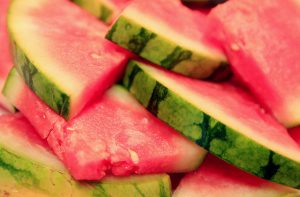Healthy Eating Habits: Beat The Heat With These Summer Foods
 Some foods have a cooling effect on the body, and many of them are in season during the steamy summer months.
Some foods have a cooling effect on the body, and many of them are in season during the steamy summer months.
Now is the perfect time to enjoy cooling foods that help us feel fresh and energized even as temperatures soar. They are also nutrient rich, and add interesting flavors and textures to our diet.
Melons, Citrus, and Tomatoes
Melons. Watermelon, being 91 percent water, helps us stay hydrated in warm weather. It provides the nutrients lycopene, vitamins C, B6, and A, plus potassium and magnesium—and is only 46 calories per cup. Other cooling melons to enjoy are cantaloupe, muskmelon, and honeydew.
Citrus Fruits. Lemons, oranges, grapefruits, and limes – all bursting with fiber, vitamin C, and an abundance of antioxidants. Putting lemon or lime in your drinking water makes a refreshing summer cooler.
Tomatoes. Fresh tomatoes are rich in lutein, lycopene, several vitamins and minerals. Research indicates organic tomatoes are our best option since they are more nutrient dense than those conventionally grown.
Dandelion Leaves, Watercress, and Sprouts
Dandelion Leaves. Leaves of the mighty dandelion provide an array of vitamins, minerals, and lesser-known beneficial compounds such as inulin, levulin, and taraxicin. The leaves can be added to soups and salads, juiced, dried to make tea, or cooked as you would spinach.
Watercress. The unassuming watercress is one of the most nutrient packed veggies available. Add this vitamin and mineral powerhouse to salads, soups, sandwiches, or steam it.
Sprouts. Sprouts are a smorgasbord of vitamins, minerals, enzymes, and antioxidants. They can be eaten as is, tossed into salads, added to a sandwich, or used in a smoothie. There are many types including mung bean, sunflower, pea, or broccoli sprouts.
Bananas, Rhubarb, and Cucumbers
Bananas. Dopamine and the B vitamins – including B6 – are banana nutrients known to support a good mood. Plus, bananas provide fiber, antioxidants, vitamin A, and compounds that nourish our body’s beneficial bacteria.
Rhubarb. One cup of rhubarb is loaded with fiber, B vitamins, vitamins K, C, A, folate, riboflavin, niacin, plus a slew of minerals. By juicing raw rhubarb with other fresh veggies or fruits, you can get its benefits without adding a lot of sugar to cut rhubarb’s tart taste. (Only eat the stalks—rhubarb leaves are poisonous.)
Cucumbers. Like watermelon, cucumbers are mostly water, and keep us hydrated. Enjoy their cool crispness as a stand alone snack, on a sandwich, in a salad, or smoothie to get vitamin C, beta-carotene, several B vitamins, and antioxidants.
Source: Mercola
Photo credit: Pink Sherbet Photography
 Eating Disorder Self Test. Take the EAT-26 self test to see if you might have eating disorder symptoms that might require professional evaluation. All answers are confidential.
Eating Disorder Self Test. Take the EAT-26 self test to see if you might have eating disorder symptoms that might require professional evaluation. All answers are confidential.